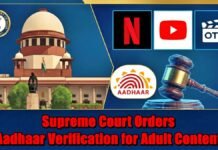
Key Points
- Information Technology Amendment Rules 2025 come into effect from November 15, 2025
- Only Joint Secretary-level officials or DIG-rank police can order content removal
- Platforms must provide detailed legal justification for every takedown
- Monthly review system by secretary-level officials to prevent arbitrary removals
- Rules replace vague “notifications” with transparent “intimations”
- Enhanced creator protection through accountable content moderation process
New Delhi: The most significant reform under the new IT Amendment Rules 2025 establishes senior-level accountability for content removal decisions on all digital platforms and social media intermediaries. Under the amended Rule 3(1)(d), only government officials holding the rank of Joint Secretary or equivalent (or Director rank if the Joint Secretary position is not appointed) can issue takedown directions to platforms like Instagram, YouTube, X, Facebook, and other social media intermediaries.
For law enforcement agencies, the authority to order content removal has been restricted to specially authorized Deputy Inspector General of Police (DIG) level officers and above, eliminating the possibility of junior officials making arbitrary or unsubstantiated takedown requests. This hierarchical safeguard represents a fundamental shift from the previous system, where officials at various levels could issue removal notices, sometimes leading to inconsistent or unjustified content removals that affected creators and users.
The Ministry of Electronics and Information Technology notified these amendments on October 31, 2025, with implementation scheduled for November 15, 2025, providing platforms and government departments adequate time to establish new protocols and train officials on the revised procedures. This senior-level authorization requirement aims to ensure that every content removal decision undergoes thorough evaluation before being communicated to social media companies.
Transparent Legal Intimations Replace Vague Notifications
A groundbreaking procedural change introduces mandatory “intimations” that replace the previously used “notifications” for content removal communications. This terminology shift reflects a deeper commitment to transparency and legal accountability in content moderation processes. When any post, video, or content is removed from platforms like Instagram, YouTube, or X, users will now receive comprehensive intimations that include specific details about the legal basis for removal.
Each intimation must clearly specify the exact law under which the action was taken, identifying the specific statutory provision that the content allegedly violated. The communication must articulate the precise reason for content removal in legally accurate language, rather than vague references to community guidelines or generic policy violations. Additionally, platforms are required to identify the applicable section of law, providing direct legal references that users can verify.
Most importantly, intimations must include hyperlinks to the relevant legal provisions, enabling creators and users to independently review the statutory basis for content removal without needing specialized legal knowledge. This level of detail empowers content creators to understand exactly why their content was removed and whether the action was legally justified, creating opportunities for informed appeals and reducing confusion around platform moderation decisions.
Monthly High-Level Review System Ensures Accountability
The IT Amendment Rules 2025 introduce an unprecedented monthly review mechanism designed to prevent misuse of takedown powers and protect legitimate content creators from unfair censorship. Under this system, a secretary-level government official will conduct comprehensive monthly reviews of all content removal orders issued during that period, evaluating whether each takedown was legally justified and procedurally sound.
This oversight mechanism creates an internal accountability loop within government departments, ensuring that officials issuing takedown notices face regular scrutiny of their decisions. The monthly review process will examine whether the statutory provisions cited actually applied to the removed content, whether the content genuinely violated Indian law, and whether the takedown was proportionate and necessary. If the review identifies patterns of unjustified removals or procedural irregularities, corrective actions can be taken against responsible officials.
The review system particularly benefits content creators who have experienced content removal, as patterns of questionable takedowns will be identified and addressed at senior levels. This creates a deterrent against arbitrary or politically motivated content censorship while protecting creators’ right to freedom of expression within legal boundaries. The transparency and accountability introduced through monthly reviews represent a significant evolution from the previous system that lacked structured oversight of takedown decisions.
Enhanced Due Diligence Obligations for Social Media Platforms
Beyond government accountability, the amended rules strengthen due diligence obligations for Social Media Intermediaries (SMIs) and Significant Social Media Intermediaries (SSMIs). The framework clearly defines SMIs as platforms that primarily enable online interaction between users, allowing them to create, upload, share, disseminate, modify, or access information. SSMIs are designated as social media intermediaries exceeding user thresholds specified by the Central Government, typically encompassing major platforms like Meta (Facebook, Instagram), Google (YouTube), and X.
These platforms must now implement robust systems to process takedown intimations according to the new procedural requirements, ensuring that every content removal is properly documented with complete legal justification. Intermediaries are required to maintain detailed records of all removal actions, including the authorizing official’s details, the specific legal provisions invoked, and the exact content removed, creating an audit trail that supports accountability and transparency.
The amendments also clarify safe harbor protections under Section 79 of the Information Technology Act 2000, specifying that intermediaries acting in good faith to remove or disable information based on government intimations or grievance mechanisms will retain legal immunity. This provision encourages platforms to comply with legitimate takedown orders without fear of liability, while simultaneously protecting them from consequences of government-ordered removals that may later be deemed unjustified.
Additional Provisions for AI-Generated Content Labeling
Parallel to content removal reforms, the IT Amendment Rules 2025 introduce comprehensive requirements for labeling and disclosure of synthetically generated or AI-created content. Social media users posting AI-generated or significantly AI-modified content must clearly identify such material through prominent labels or notices, ensuring viewers understand when they are consuming artificially generated information rather than authentic human-created content.
The rules mandate that at least 10 percent of the visual display area for images and videos, or the initial 10 percent of audio clip duration, must be devoted to clear disclaimers indicating AI generation or modification. Significant Social Media Intermediaries are required to implement reasonable and appropriate technical measures to verify the accuracy of user declarations regarding AI-generated content, considering the nature, format, and source of the information.
When content is determined to be synthetically generated, platforms must display clear labels or notices prominently, preventing the spread of potentially misleading AI-generated material without proper context. These provisions address growing concerns about deepfakes, synthetic media manipulation, and the use of AI tools to create misleading content, particularly in political and social contexts where authenticity is crucial.
Impact on Content Creators and Digital Rights
The IT Amendment Rules 2025 represent the most creator-friendly reform of content moderation processes since the original IT Rules 2021 were notified in February 2021. By restricting takedown authority to senior officials, requiring detailed legal justifications, and implementing monthly oversight reviews, the government has created multiple layers of protection against arbitrary content censorship that has plagued digital creators across India.
Creators producing content on Instagram, YouTube, X, and other platforms will benefit from increased transparency, knowing exactly why content was removed and which specific law was allegedly violated. This clarity enables more effective appeals and legal challenges when creators believe removal was unjustified. The monthly review system creates opportunities for wrongful takedowns to be identified and potentially reversed, offering recourse that was previously unavailable.
However, some digital rights organizations have expressed concerns about aspects of the implementation. The Internet Freedom Foundation noted that while the amendments introduce welcome transparency measures, they operate parallel to the Sahyog Portal system that allows government ministries to request takedowns through an inter-ministerial coordination mechanism. The organization highlighted that monthly internal reviews by the same government department that requested takedowns may lack the independence of judicial oversight, potentially limiting the effectiveness of accountability measures.
Historical Context and Previous Amendments
The Information Technology Rules 2021 were originally notified on February 25, 2021, establishing comprehensive due diligence obligations for intermediaries with objective of ensuring online safety, security, and accountability. These foundational rules underwent amendments on October 28, 2022, and April 6, 2023, progressively refining the regulatory framework governing digital platforms and social media companies operating in India.
The 2025 amendments represent the most substantial revision since the original rules were introduced, fundamentally restructuring the content removal process to address criticism that previous versions allowed excessive government control over online speech with insufficient transparency or accountability. The phased evolution of IT Rules reflects the government’s ongoing efforts to balance legitimate law enforcement needs with protection of fundamental rights, including freedom of expression and access to information.
Implementation Timeline and Enforcement
With the November 15, 2025, implementation date now in effect, all social media platforms, digital intermediaries, and government departments must fully comply with the new procedural requirements. Platforms have been required to update their content moderation systems, establish protocols for processing detailed intimations with legal justifications, and implement technical measures for AI-content labeling and verification.
Government ministries and law enforcement agencies have undergone internal restructuring to ensure that only authorized senior officials issue takedown notices and that monthly review mechanisms are operationalized. The Ministry of Electronics and Information Technology will monitor compliance across platforms and government departments, with potential penalties for non-compliance, including withdrawal of safe harbor protections for intermediaries and disciplinary action for government officials who violate procedural requirements.
Global Context and International Comparisons
India’s IT Amendment Rules 2025 place the country among a growing number of jurisdictions implementing structured content moderation frameworks that balance platform accountability with user rights protection. The European Union’s Digital Services Act similarly requires detailed justifications for content removal and establishes oversight mechanisms, while countries like Australia and Canada have introduced legislation mandating transparency in platform moderation decisions.
The Indian approach is distinctive in its emphasis on senior-level government authorization for takedown requests, creating hierarchical accountability that differs from purely platform-driven moderation systems prevalent in the United States. By combining government accountability measures with enhanced user transparency rights, the IT Amendment Rules 2025 attempt to navigate the complex balance between content regulation and freedom of expression in the world’s largest democracy and one of its fastest-growing digital markets.



















































